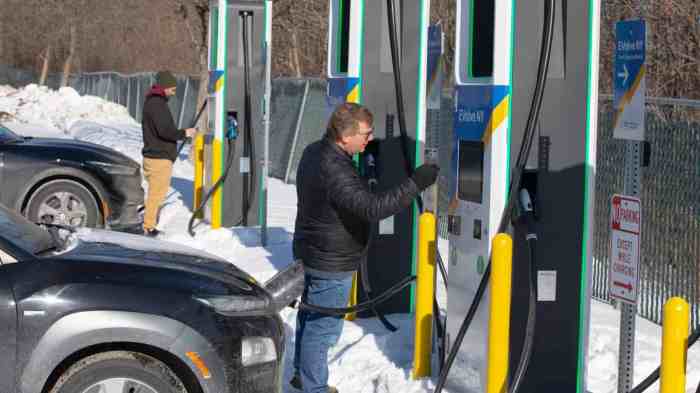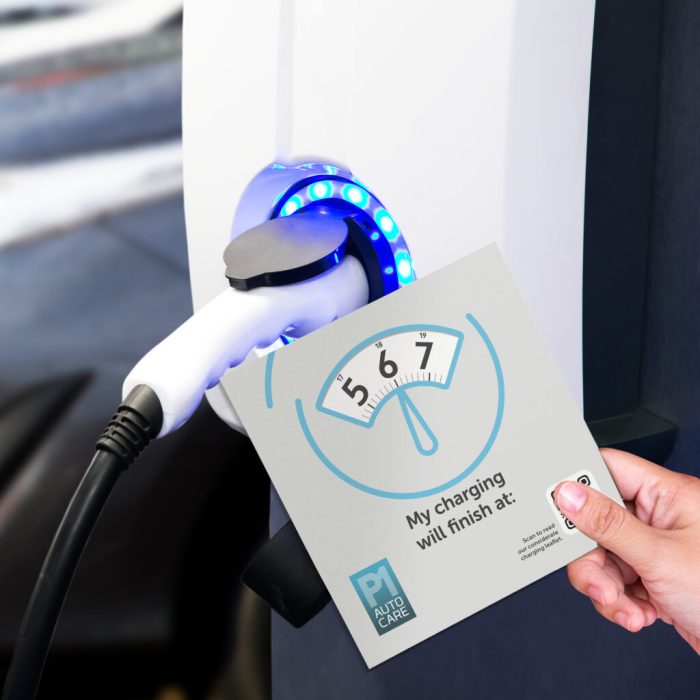EV charging etiquette at public stations: It’s more than just plugging in and powering up. Think of it like sharing a coveted study spot in the library – you wouldn’t hog it all day, right? This guide breaks down the dos and don’ts of responsible EV charging, ensuring a smooth experience for everyone and keeping those charging stations humming.
From understanding different connector types and charging speeds to knowing how to handle malfunctions and respecting fellow EV drivers, we’ll cover it all. We’ll even look at how technology might make the whole process even easier (and more polite!) in the future. Get ready to become a pro at public EV charging!
Understanding Public EV Charging Station Infrastructure

Navigating the world of public EV charging can feel a bit like entering a new technological landscape. Understanding the infrastructure, however, is key to a smooth and efficient charging experience. This section will break down the key components and processes involved in using public EV charging stations.
Public EV charging stations come in various shapes and sizes, but they generally share some common features. Most stations have a central unit that houses the power electronics and communication systems. This unit is usually mounted on a sturdy pole or wall-mounted structure. From this central unit, individual charging connectors are dispensed, often with a clear indication of the charging level and connector type.
Many stations also include informational displays, sometimes with touchscreens, showing the charging status, cost, and available payment options. Some stations also incorporate features like lighting for nighttime use and security cameras.
Public EV Charging Station Components and Layout
A typical public EV charging station consists of several key components working together. These include the power supply (often connected to the grid), the charging station controller (managing power distribution and communication), charging connectors (the physical interface for the EV), payment systems (credit card readers, mobile payment options), and user interface elements (displays and sometimes touchscreens) to provide feedback to the user.
The layout varies depending on the size and number of charging points but generally follows a user-friendly design, maximizing accessibility and space efficiency. The station may be free-standing, wall-mounted, or integrated into other structures, like parking garages.
EV Charging Connectors and Compatibility
Several different connector types exist for EV charging, leading to some confusion for new EV owners. The most common types are: J1772 (Level 1 and Level 2 AC charging), CCS1 (Combined Charging System 1, used for both AC and DC fast charging in North America), and CHAdeMO (a DC fast charging standard primarily used in Japan and some other parts of the world).
Tesla vehicles use their proprietary connector, but Tesla adapters are available for other charging stations. Understanding which connector your EV uses is critical for choosing compatible charging stations. Many charging station apps provide details about connector types available at each location. For example, a station might offer both J1772 and CCS1 connectors, allowing compatibility with a wider range of EVs.
Locating and Accessing Public EV Charging Stations, EV charging etiquette at public stations
Finding a public EV charging station is now much easier thanks to numerous mobile apps and online mapping tools. Popular apps like ChargePoint, Plugshare, and Electrify America provide comprehensive databases of charging stations, allowing users to search by location, connector type, and other criteria. These apps often show real-time availability of chargers, which is extremely useful for avoiding disappointment.
Many also integrate with navigation systems, providing turn-by-turn directions to the chosen station. Online maps such as Google Maps also increasingly integrate EV charging station data, making it simple to find charging options along a planned route. Some apps allow users to reserve charging spots in advance, particularly during peak hours.
Charging Speed Comparison
| Charging Level | Connector Type (Examples) | Typical Charging Speed | Notes |
|---|---|---|---|
| Level 1 | J1772 (120V) | 1-5 miles of range per hour | Suitable for overnight charging at home |
| Level 2 | J1772 (240V), Tesla Connector | 10-40 miles of range per hour | Common for home and public charging |
| DC Fast Charging | CCS1, CHAdeMO | 100+ miles of range per hour | Fastest charging option, typically found at highway rest stops |
Responsible Charging Behavior
Sharing public EV charging stations is all about being considerate of other drivers. Think of it like sharing a library – we all need access, and a little courtesy goes a long way. Let’s explore how to make the most of these shared resources.Proper charging etiquette isn’t just about being nice; it’s about ensuring everyone can charge their EVs and get where they need to go.
Following these guidelines helps create a smooth and efficient experience for everyone using the charging network.
Unplugging After Charging
Once your EV is fully charged, promptly unplug your vehicle from the charging station. Leaving your car plugged in unnecessarily blocks access for other drivers who might need to charge. This is especially crucial during peak hours or at stations with limited charging points. Imagine you’re running late for a meeting and the only available charger is occupied by a fully charged car – frustrating, right?
Unplugging when finished is a simple act of consideration that prevents this kind of inconvenience.
Connecting and Disconnecting Charging Cables
Before connecting, ensure the charging port on your vehicle and the charging station are clean and free of debris. Gently insert the connector, ensuring a secure connection. When disconnecting, gently pull the connector from the vehicle’s charging port, avoiding any jerky movements that could damage the cable or port. Treat the cables with care – they’re shared resources and need to last.
A damaged cable means a less functional charging station for everyone.
Sharing Charging Stations with Other EV Drivers
If you arrive at a busy station and all chargers are in use, be mindful of the estimated charging times displayed on the station (if available). If you anticipate a long charging session, consider politely inquiring if others need the charger sooner. Communicating respectfully can help coordinate charging times and prevent unnecessary waits. Cooperation is key – perhaps you can arrange to switch places once you’ve reached a sufficient charge level.
This shows consideration and promotes a positive charging experience for everyone.
Minimizing Charging Time
Pre-conditioning your vehicle’s battery to the optimal temperature before arriving at a charging station can significantly reduce charging time. Many EVs allow for pre-conditioning via their mobile apps. Additionally, using the appropriate charging level for your needs (Level 2 versus DC fast charging) helps optimize charging speed and station availability. For instance, if you only need a top-up, opt for a slower Level 2 charger instead of hogging a fast charger unnecessarily.
This maximizes the number of vehicles that can be charged efficiently.
Addressing Charging Station Issues
So, you’ve arrived at a charging station, plugged in, and…nothing. Or maybe something went wrong with the payment. Don’t panic! Knowing how to handle common problems can make your EV charging experience much smoother. This section covers troubleshooting common issues and reporting problems to get things fixed quickly.Troubleshooting charging station problems often involves a combination of checking the obvious and knowing who to contact for help.
So, like, EV charging etiquette is a real thing, right? Unplugging when you’re done is basic, but it gets more complex. If you’re rocking one of the luxury EVs with the longest range, as detailed on this awesome list Luxury electric cars with longest range 2025 , you might need the charger longer, but still, be mindful and unplug promptly once your car’s topped off.
Let’s keep those public chargers flowing smoothly, people!
Remember, a little patience and methodical problem-solving can usually get you back on the road.
Seriously, people, unplug when you’re done charging at public EV stations – it’s basic etiquette! Thinking about the long-term costs? Check out this article on EV battery leasing options 2025 to see if leasing might be a better financial fit for you. Knowing your charging options helps you plan better and, you know, not hog a station.
Respect the shared resources, guys!
Reporting Malfunctioning Charging Stations
Reporting a malfunctioning charging station is crucial for ensuring the network remains reliable for everyone. Most charging networks have a dedicated customer support line or online portal. Start by carefully noting the station’s location, identifying number (often found on a sticker on the station itself), and a detailed description of the problem (e.g., “Error code displayed: E123,” or “Charger won’t turn on”).
Then, contact the network operator using their provided contact information, usually found on the station or their app. Many networks have apps that allow for in-app reporting, making the process very simple. Be prepared to provide photos or videos of the problem if requested.
Addressing Payment System Problems
Payment system issues can be frustrating, but often have straightforward solutions. If your payment is declined, first check your bank account to ensure sufficient funds and that your card details are correct. If the issue persists, try a different payment method if the station accepts multiple payment types (credit card, debit card, mobile payment apps). If you’re still unable to initiate a charge, contact the charging station network’s customer support.
They can investigate potential problems with their system or provide alternative payment options. Keep a record of any error messages or transaction numbers you encounter.
Troubleshooting Common Charging Issues
Before calling for help, try a few basic troubleshooting steps. First, ensure your EV is properly plugged into the charging station. A loose connection is a surprisingly common culprit. Next, check the charging cable itself for any visible damage, such as frayed wires or broken connectors. If using a portable charger, try a different cable if possible.
Finally, consider whether there might be a broader power outage affecting the area. Check if other nearby devices are working. If the problem persists after these checks, contact the charging network’s support.
Common Charging Station Problems and Potential Solutions
It’s helpful to have a quick reference guide for common problems. Here are some common issues and their potential solutions:
- Problem: Charging cable won’t connect. Solution: Check for obstructions, ensure the cable is fully inserted, and try a different cable if available.
- Problem: Charging station displays an error code. Solution: Note the error code and contact the charging network’s customer support.
- Problem: Payment is declined. Solution: Verify sufficient funds and correct card details; try an alternative payment method; contact customer support.
- Problem: No power to the charging station. Solution: Check for a broader power outage; contact the charging network’s customer support.
- Problem: Charging is too slow. Solution: Check the charging station’s amperage rating; ensure your vehicle is set to accept the appropriate amperage; contact customer support if it’s significantly slower than expected.
Respecting Other Users and the Environment

Sharing public EV charging stations is all about community. Just like any shared resource, a little consideration goes a long way in ensuring everyone has a positive experience. Maintaining a clean and respectful environment is key to making sure the charging infrastructure remains accessible and enjoyable for all users.Proper etiquette at public charging stations goes beyond just plugging in your car.
It involves actively contributing to a clean and functional space, minimizing disruptions to others, and showing respect for both the equipment and the environment. This section will cover some simple yet impactful ways to be a good neighbor while charging your EV.
Maintaining a Clean and Orderly Environment
Keeping the area around charging stations clean and tidy is essential. This means picking up after yourself—no leaving trash, food wrappers, or charging cables strewn about. A simple wipe-down of any spills or messes you might make is also a great gesture. Imagine returning to a charging station that’s as clean and organized as you left it – that’s the kind of positive impact we’re aiming for.
Think of it as leaving the space better than you found it.
Proper Disposal of Trash and Recycling Materials
Most public charging stations are located in areas with designated trash and recycling receptacles. Always utilize these appropriately. Separating recyclable materials like plastic bottles and aluminum cans demonstrates environmental responsibility and helps keep the area clean. If recycling bins are unavailable, taking your trash with you is always the responsible choice. Even a small act like properly disposing of a single water bottle makes a difference in maintaining a cleaner and more sustainable charging environment for everyone.
Minimizing Noise Pollution
While charging your vehicle, be mindful of noise levels. Avoid loud conversations or playing music at high volumes. Remember, charging stations are often located in public spaces where others might be nearby, working, or simply trying to relax. Respecting the quiet and peaceful atmosphere of the charging area makes it a more pleasant experience for everyone. Consider using headphones or earbuds if you need to listen to audio while waiting for your car to charge.
Future of Public EV Charging Etiquette
The future of public EV charging etiquette hinges on technological advancements and innovative solutions to address the growing demand for charging infrastructure. As more electric vehicles hit the road, efficient and equitable access to charging becomes paramount, necessitating a proactive approach to managing charging station usage and fostering a respectful environment for all users. This involves not only improving the technology itself but also rethinking how we design and implement charging station networks.
Technological improvements will play a significant role in shaping future charging etiquette. Smart scheduling systems, for example, could optimize charging times, minimizing wait times and maximizing station utilization. Improved user interfaces, coupled with real-time data on station availability and charging times, will empower drivers to make informed decisions, reducing conflicts and enhancing overall user experience.
Smart Scheduling and User Interfaces
Advanced scheduling systems, integrated with navigation apps and vehicle onboard computers, could allow drivers to reserve charging slots in advance, similar to booking a doctor’s appointment or a restaurant table. This would eliminate the frustrating experience of arriving at a station only to find all chargers occupied. Imagine a system where your car communicates directly with the charging station, automatically reserving a slot based on your arrival time and predicted charging needs.
User interfaces could be significantly enhanced with interactive maps displaying real-time availability, predicted wait times, and even charging prices. Clear visual cues on the station itself, such as color-coded lights indicating availability, would further improve the user experience.
Addressing Increasing Demand and Ensuring Equitable Access
Meeting the surging demand for public EV charging requires a multi-pronged approach. Strategic placement of charging stations in high-traffic areas and along major transportation routes is crucial. However, simply increasing the number of stations isn’t enough; equitable access for all communities, regardless of socioeconomic status or geographic location, is essential. This could involve government incentives for installing charging stations in underserved areas and partnerships with private businesses to expand charging networks into diverse communities.
Furthermore, investment in fast-charging infrastructure is critical to reducing charging times and alleviating congestion at popular locations.
Managing Charging Station Usage in High-Demand Areas
Different approaches to managing charging station usage in high-demand areas exist. One approach involves implementing tiered pricing structures, with higher charges during peak hours to incentivize off-peak charging. Another approach is implementing time limits on charging sessions, ensuring that no single user monopolizes a station for extended periods. A third, potentially more equitable approach, could involve a reservation system with a fair allocation policy, giving priority to those who have pre-booked or have a longer journey ahead.
Each approach has its own advantages and disadvantages, and the optimal strategy may vary depending on local conditions and user needs.
Hypothetical Future Charging Station Scenario
Imagine a futuristic public charging station located in a bustling city center. The station is equipped with sleek, modular charging units that can adapt to various vehicle types. A large, interactive touchscreen display shows real-time availability, estimated wait times, and pricing information. Drivers can reserve a charging slot through a mobile app, receiving notifications about their reservation status and estimated completion time.
The station is seamlessly integrated with the city’s smart grid, optimizing energy consumption and minimizing environmental impact. Solar panels on the station’s roof provide renewable energy, further enhancing its sustainability. Users are encouraged to follow a simple, universally understood etiquette system displayed clearly on the touchscreen and at each charging point, promoting responsible and courteous behavior. The entire experience is intuitive, efficient, and stress-free, fostering a positive perception of public EV charging.
End of Discussion: EV Charging Etiquette At Public Stations
So, next time you’re hunting for a charging spot, remember the golden rule: treat the station like you’d want others to treat it. By following a few simple guidelines, we can create a positive and efficient charging experience for everyone. Let’s keep those EVs rolling and the charging stations readily available – it’s all about good vibes and shared responsibility.









